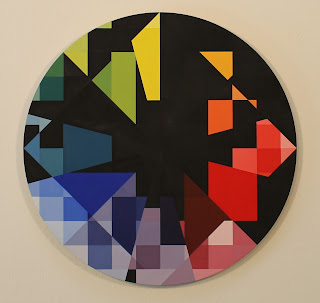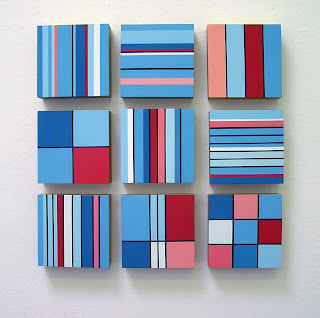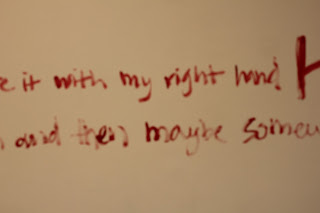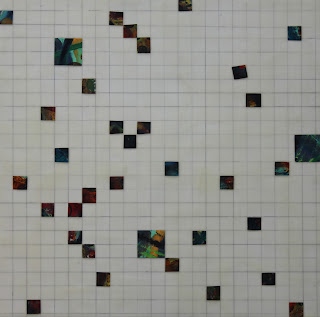Interview With Artist, Leslie Love Stone
What kind of art do you make?
I am a painter, illustrator, and graphic designer who uses any medium or vehicle that best fleshes out my subject. Lately, I’ve been painting on smaller wood panels and mixing a full spectrum of colors, including black, from three hues only. The limitations are intriguing and ultimately appropriate to my current series. My work is a blend of well-crafted theory and application, intuition and intellect; it is abstract, mathematical, and elegant in its simplicity.
 |
| Leslie Love Stone, 2012. |
When did you consider yourself to be an artist?
I can see very clearly a seminal moment when I was six—and there have been others at eight, ten, and fifteen—but, as someone who has had a full and successful career in another field, the point-of-no-return occurred the first time I sat down at the work table in my CGU studio. It was sublime.
After school, where do you plan to locate your studio? Do you have a plan for how you’ll set it up?
My first priority is finding a job. I’d really like to teach at a university, but positions are not readily available. Plan A is to take any full-time, tenure-track position offered, no matter where it is. (I have the luxury of being able to easily relocate.) Plan B is to look for an art-related position, perhaps in a gallery or museum. I hold undergraduate and graduate degrees with concentrations in finance, economics, marketing, and international business; and I have had an executive-level career and served on several nonprofit boards. Add that to an MFA and somewhere in there is the right mix of skills for somebody. Bottom line: Once I find a job—wherever that is—I’ll establish a studio. My set-up here at CGU is great and I’ve made sure everything is mobile and easily transported. The only thing I won’t be taking with me is the sink.
Does your studio location influence your work?
I believe the successful professional artist must establish a daily schedule and stick to it. It’s a job. So, for me, I need a place that is independent from my home, a place where all my work can be left in-process to be continued the next workday. I’ve always put in a lot of hours, but somewhere early in my career, I learned that if I were ever to have balance in my life, I had to keep work and home separate. I never take work home. I may stay at the office or studio for 14 hours, but I never take work home. I also never bring personal issues into my workplace; it’s just not professional.
Describe a typical day of work.
I get up between 6:30 and 7:30 to work on projects that require the computer, which might include writing, designing, or researching. I like to hit the studio around 10 and work until 6-ish. I usually stay in for lunch and take a walk-break sometime in the afternoon. I try to have two to three pieces going at the same time to minimize my downtime—there’s nothing worse than sitting around waiting for paint to dry. I typically work Monday through Friday, but will occasionally come into the studio on a weekend if I have a deadline or don’t want to leave a piece for two days.
What materials do you most often use?
Right now, it’s just paint and panel.
What is your most coveted studio furniture piece?
My studio is my office. All I need is a flat surface and a little elbow room.
What unique tools or devices do you use that are critical to your process?
It’s an interesting topic. I think I could make art with anything and often get into the questionable practice of using the same brush to perform widely different duties. Many of my colleagues are tools experts and pride themselves on knowing which specialized instrument performs what precise task. But that’s just not me. I would make a terrible dental hygienist and, if I could, I’d play the entire round of golf with just my seven iron.
Can you tell me about an item in your studio that has significance to you?
I believe that failure is a step on the way to success, that success is often 99% failure. I have a canvas in my studio from one of the first paintings I ever made. The painting was hideous and no matter how hard I tried to resolve it, I just couldn’t. But I learned some things and went onto the next painting and the painting after that and here I am in grad school. I put a little piece of that canvas on the back of every painting I make.
Describe your project schedule.
I am currently working on a series entitled, Segments. I’d like to finish it by the end of September so I can start on the next one. My goals for the summer include completing the redesign of my Web site and related collateral, photographing my work-to-date, and writing my thesis statement.
Where/when do you let ideas percolate?
I can’t think of a time when I’m not letting ideas percolate.
How often do you clean your studio?
My studio is fairly organized and stays pretty clean, which clearly requires ongoing maintenance. Typically, I sweep and mop on Friday afternoons before I go home.
How do you title your work?
No formal process—I just let the content drive the title.
Have you or would you work for another artist?
I would definitely work as an artist’s assistant. What I won’t do is create work on another artist’s behalf. Art is not composition; it is composition and execution.
Tell me your artist motto, manifesto, or creed.
A manifesto is simply a public announcement of intention. I began working on mine after seeing a presentation from another artist who shared hers. A few months later, I thought, “Why am I writing this?!!” As a visual communicator, painting my manifesto certainly makes more sense. The four tenets employ blues and browns to convey possibility and clarity, the unknown and the known; they express my intention to:
- Balance intuition and intellect, my life and my art practice. The kind of person I am is more important than the kind of artist I am.
- Make art to consider things I don’t know, not reinforce things I do. Searching for the truth is more important than finding it.
- Encompass other perspectives. Allowing other viewpoints is the only way to achieve complete understanding. I am the sky; I have room for everyone.
- Respect the dignity of all living beings. I feel a special responsibility to those who cannot choose for themselves the course of their own lives. To use them in my practice would be oppressive and exploitative. Therefore, I do not use animals or children (alive or dead) in my art.
Any advice for other artists?
Work hard. Put in the hours. Roll up your sleeves, start where you are, and work with what you have. Focusing on failures, setbacks, and missteps serves no purpose. You can only get to the joyful, transcendent moments when you keep going.
Any question I should have asked?
I think I would have asked about process. It seems like artists fall into one of two groups: they either jump in and let the materials take them to a sometimes surprise ending or they do the thinking up front, making the process more about implementation. I am the latter. I don’t make every decision before I start painting, but the “figuring it out” is a cerebral event and, for me, the joyful part of making art. Some people like suspense thrillers because they are stimulated by the rush of unexpected action; I like mysteries because they are puzzles to be solved.
 |
| Leslie Love Stone, 2012. |
To see more of Leslie's work check out her
website.
I cannot thank Leslie enough for her time and consideration in her responses to my questions.

















































